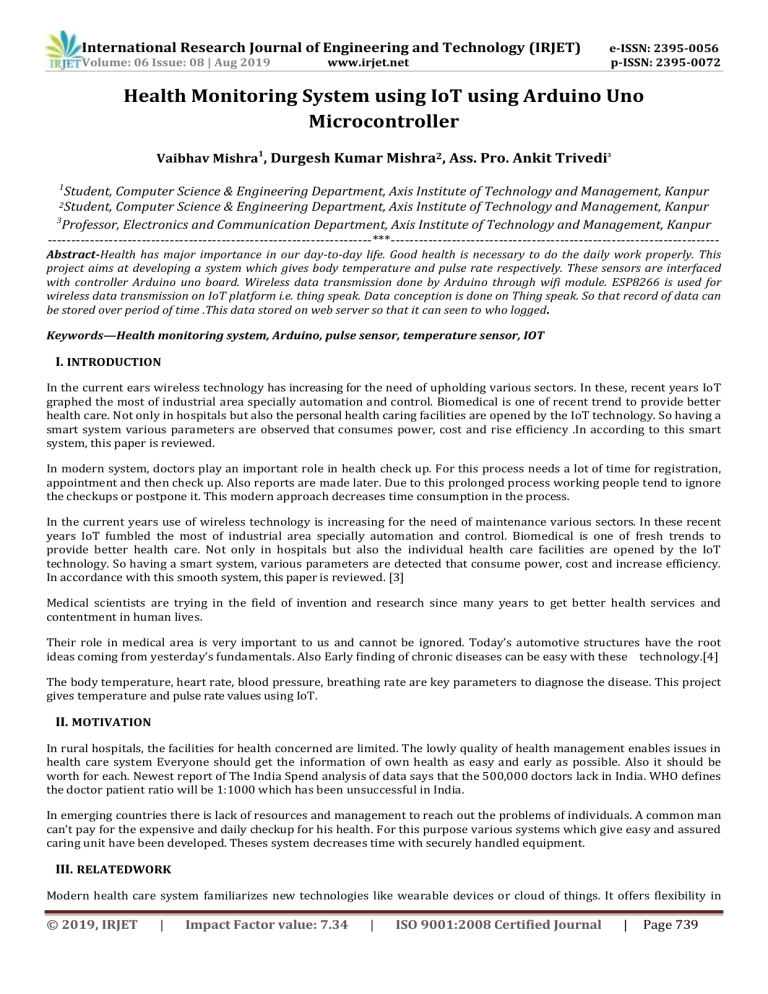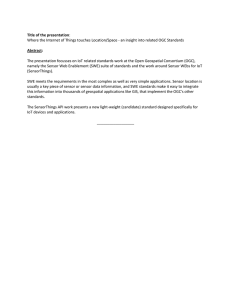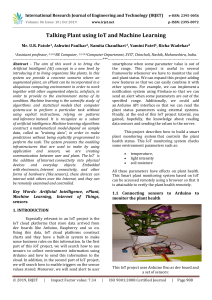IRJET-Health Monitoring System using IoT using Arduino Uno Microcontroller
advertisement

International Research Journal of Engineering and Technology (IRJET) Volume: 06 Issue: 08 | Aug 2019 www.irjet.net e-ISSN: 2395-0056 p-ISSN: 2395-0072 Health Monitoring System using IoT using Arduino Uno Microcontroller Vaibhav Mishra1, Durgesh Kumar Mishra2, Ass. Pro. Ankit Trivedi3 1 Student, Computer Science & Engineering Department, Axis Institute of Technology and Management, Kanpur Computer Science & Engineering Department, Axis Institute of Technology and Management, Kanpur 3 Professor, Electronics and Communication Department, Axis Institute of Technology and Management, Kanpur ---------------------------------------------------------------------***---------------------------------------------------------------------2Student, Abstract-Health has major importance in our day-to-day life. Good health is necessary to do the daily work properly. This project aims at developing a system which gives body temperature and pulse rate respectively. These sensors are interfaced with controller Arduino uno board. Wireless data transmission done by Arduino through wifi module. ESP8266 is used for wireless data transmission on IoT platform i.e. thing speak. Data conception is done on Thing speak. So that record of data can be stored over period of time .This data stored on web server so that it can seen to who logged. Keywords—Health monitoring system, Arduino, pulse sensor, temperature sensor, IOT I. INTRODUCTION In the current ears wireless technology has increasing for the need of upholding various sectors. In these, recent years IoT graphed the most of industrial area specially automation and control. Biomedical is one of recent trend to provide better health care. Not only in hospitals but also the personal health caring facilities are opened by the IoT technology. So having a smart system various parameters are observed that consumes power, cost and rise efficiency .In according to this smart system, this paper is reviewed. In modern system, doctors play an important role in health check up. For this process needs a lot of time for registration, appointment and then check up. Also reports are made later. Due to this prolonged process working people tend to ignore the checkups or postpone it. This modern approach decreases time consumption in the process. In the current years use of wireless technology is increasing for the need of maintenance various sectors. In these recent years IoT fumbled the most of industrial area specially automation and control. Biomedical is one of fresh trends to provide better health care. Not only in hospitals but also the individual health care facilities are opened by the IoT technology. So having a smart system, various parameters are detected that consume power, cost and increase efficiency. In accordance with this smooth system, this paper is reviewed. [3] Medical scientists are trying in the field of invention and research since many years to get better health services and contentment in human lives. Their role in medical area is very important to us and cannot be ignored. Today’s automotive structures have the root ideas coming from yesterday’s fundamentals. Also Early finding of chronic diseases can be easy with these technology.[4] The body temperature, heart rate, blood pressure, breathing rate are key parameters to diagnose the disease. This project gives temperature and pulse rate values using IoT. II. MOTIVATION In rural hospitals, the facilities for health concerned are limited. The lowly quality of health management enables issues in health care system Everyone should get the information of own health as easy and early as possible. Also it should be worth for each. Newest report of The India Spend analysis of data says that the 500,000 doctors lack in India. WHO defines the doctor patient ratio will be 1:1000 which has been unsuccessful in India. In emerging countries there is lack of resources and management to reach out the problems of individuals. A common man can’t pay for the expensive and daily checkup for his health. For this purpose various systems which give easy and assured caring unit have been developed. Theses system decreases time with securely handled equipment. III. RELATEDWORK Modern health care system familiarizes new technologies like wearable devices or cloud of things. It offers flexibility in © 2019, IRJET | Impact Factor value: 7.34 | ISO 9001:2008 Certified Journal | Page 739 International Research Journal of Engineering and Technology (IRJET) Volume: 06 Issue: 08 | Aug 2019 www.irjet.net e-ISSN: 2395-0056 p-ISSN: 2395-0072 terms of recording patients monitored data and send it remotely via IOT. For this connection, there is necessity of protected data transmission .To transmit the data with privacy is the Motive of this paper. The proposed system presents security of health care and cloud of things. System works in dual major parts viz. storage stage and data retrieving stage. In storage stage, data is stored, updated for future use. In data retrieving stage, regain data from cloud. The cloud server can share with genuine user as per request. A patient with wear able devices repeatedly updates his record every 4 or 5min. In emergency mode, it updates for every 30sec. The wearied device will refer results to phone using Bluetooth connection or NFC technology. This can able to give to cloud server using GSM. At clouds, every patient is describes with unique address. So data at cloud can verify the right patient and provide the required request. [1] Afef Mdhaffar, Tarak Chaari, Kaouthar Larbi, Mohamed Jmaiel and Bernd Freisleben have clarified low power WAN network to perform study of monitored data in health caring system. They have recognized WAN network for communication up to the range of 33m2 at around 12 m altitude. They have also verified that power consumed by Lora WAN network is ten times less than the GPRS/3G/4G.The IOT architecture has been given for step wise working for understanding of IOT .The main purpose of Lora WAN is the energy consumption. The power consumption in idle mode for Lora WAN is 2.8mA while in GPRS is 20mA. Hardware cost in Lora WAN is 10 dollar while in GPRS is 50 dollar. Maximum data rate in Lora WAN is 50kbps (uplink), 50 kbps downlink while in GPRS is 86.5 kbps (uplink, 14kbps (downlink).These results gives the overall efficiency of Lora WAN in the demonstration of IOT for health monitoring system. [5] Mohammad M.Masud, Mohamed Adel Serhani ,and Alramzana Nujum Navaz had given the measurement of ECG signals at several intervals and at changed situations. They have considered energy awake, limited computing resources and lose network continuity challenges .For these challenges; mathematical model has been established to execute each task serially. There are three methodologies designed to work out the process .One is mobile based monitoring method, data mining and third is machine learning method [6] Ayush Bansal, Sunil Kumar, Anurag Bajpai, VijayN. Tiwari, Mithun Nayak, Shankar Venkatesan, Rangavittal Narayanan emphases on development of a system which is capable of spotting critical cardiac events. Using an advanced remote monitoring system to spot symptoms which lead to fatal cardiac events [7] Hamid Al-Hamadi and Ing-Ray Chen gives faith based health IOT protocol that reflects risk classification, reliability trust, and loss of health probability as design standards for decision making. Comparative analysis of trust based protocol and baseline protocols check viability.[8] Muthuraman Thangaraj Pichaiah Punitha Ponmalar Subramanian Anuradha.”Digital hospital “term is familiarized for hospital management. It permits automatic electronic medical records in standard. Also converses with the implemented real world setup of smart autonomous hospital management with IOT.[9] Table 1: Comparison of sensors and technology used [1, 7, 5, 6, 9] Sr. No Title of Paper Sensors used Technology used Internet Of Things (IOT) Allowed Smart Various types of Digital Hospital 1 Autonomous Hospital Management System sensors used – A Real World Health Care Use Case with the Technology Drivers Remote health monitoring system for 12-lead ECG Mobile based algorithm 2 detecting cardiac disorders probe deployment, Bluetooth sensor device IoT-based Health Monitoring via Lora B.P, Lora network 3 WAN Temp., glucose Resource-Aware Mobile-Based Health ECG ECG 4 Monitoring sensor processing analytics module Internet Of Things (IOT) Enabled Smart ECG,EKG IoT enabled data 5 Autonomous Hospital Management modeling System–A Real World Health Care Use Case with Technology Drivers © 2019, IRJET | Impact Factor value: 7.34 | ISO 9001:2008 Certified Journal | Page 740 International Research Journal of Engineering and Technology (IRJET) Volume: 06 Issue: 08 | Aug 2019 www.irjet.net e-ISSN: 2395-0056 p-ISSN: 2395-0072 IV. SYSTEM AND OVERVIEW A. Objective To develop health monitoring system using IOT, including Pulse rate and body Temperature To design a system which store the patient data over a period of time using data base management. To do analysis of collected data of sensors via clouds. B. Block Diagram Fig 1: Block diagram of system Fig1. Shows the proposed system .The health monitoring sensors are used to gather health related data i.e. for data acquisition. Communication can be done via controller for sending data on internet wirelessly. Data handling has been done at server. All data collected and gathered at server point. To get health related information in understandable for mat it can be shown on web page i.e. data management. Fig 2: Working of system Fig 2. Shows the working flow of system. The results collected from sensor are examined i.e. if abnormal behavior has been noticed, then emergency plan activated to inform the Doctor about patient’s health .So it diminishes critical conditions in Hospital. C. Components Used Table 2 gives the modules used in the system and their essential specification. Following 1) Arduino uno: Arduino uno is a micro controller based on ATMega 328. Simulation. It has a build in USB peripheral power cable © 2019, IRJET | Impact Factor value: 7.34 | ISO 9001:2008 Certified Journal | Page 741 International Research Journal of Engineering and Technology (IRJET) Volume: 06 Issue: 08 | Aug 2019 www.irjet.net e-ISSN: 2395-0056 p-ISSN: 2395-0072 standards A-B USB cable with 14 digital I/O pins. 2) Temperature Sensor: Sensor LM35 is used for measurement of body temperature. Sensor is position in contact with body and it senses body temperature. It is standardized linearly in Celsius. It has low self heating ability. Also id doesn’t require exterior calibration. 3) Pulse Sensor: When a finger is placed on sensor it starts measuring pulse rate. LED on top side will starts blinking with each heartbeat. Output pin of sensor is connected to controller. The working principle of sensor is established on light modulation by blood flow through nerves at each heart pulse. Table 2: Specification of System [10] Module Controller Item Specification Operating voltage, 5V,14,32 KB digital pins, Flash memory Temperature Temperature range, power, output -55C to 150C,4- 30V, 0.1W for sensor impendence 1mA load Pulse sensor LED, gain, Power Infrared(transmitterreceive)LED,100, 3.3V Wifi module Power, boud rate, range 3.3V,9600BPS, Up to 10m LCD display, power plasma display, 5v 4) Wifi Module: ESP8266 wifi module is a self enclosed SOC with incorporated TCP/IP protocol stack that can offer any controller access to wifi network. It uses 802.11 b/g/n protocols. Standby power consumption is less than 0.1mW. 5) IoT Platform: • It Uses the Things speak platform to send data to cloud from any Internet-enabled device. • You can then configure actions and alerts based on your real-time data and unlock the value of your data through graphic tools. • Use the Thing speaks proposed a platform for developers that enable them to easily capture sensors data and change it into use full information. D) Results Fig 3 shows the interfacing of controller to sensors & LCD. Fig 3: Interfacing of LCD and sensors with Arduino © 2019, IRJET | Impact Factor value: 7.34 | ISO 9001:2008 Certified Journal | Page 742 International Research Journal of Engineering and Technology (IRJET) Volume: 06 Issue: 08 | Aug 2019 www.irjet.net e-ISSN: 2395-0056 p-ISSN: 2395-0072 Fig 4: Setup of System Fig 4 shows the Output on LCD of pulse sensor and temperature sensor. Fig 5: Simulation of system on Arduino IDE Fig 5 is the simulation window of Arduino IDE of program. Fig 6.gives parameters that are body temperature and pulse rate is shown online on IOT platform. Fig 6: Graphs of sensor output © 2019, IRJET | Impact Factor value: 7.34 | ISO 9001:2008 Certified Journal | Page 743 International Research Journal of Engineering and Technology (IRJET) Volume: 06 Issue: 08 | Aug 2019 www.irjet.net e-ISSN: 2395-0056 p-ISSN: 2395-0072 Acknowledgement The author would like to thank to department of electronics and communication for providing various test components and Ass.pro. Ankit Trivedi for guiding about project. REFERENCES 1. Ebrahim Al Alkeem1, Dina Shehada1, Chan Yeob Yeun1,M. Jamal Zemerly ,Jiankun Hu “New secure healthcare system using cloud of things”, Springer Science+Business Media New York2017 2. Yena Kim, SeungSeob Lee and SuKyoung Lee “Coexistence of ZigBee-based WBAN and WiFi for Health Tele monitoring Systems” , DOI 10.1109/JBHI.2014.2387867, IEEE Journal of Biomedical and Health Informatics 3. Mirza MansoorBaig& Hamid Gholamhosseini “Smart Health Monitoring Systems: An Overview of Design and Modeling”, Springer Science Business Media New York2013 4. S.M.Riazulislam ,Daehankwak, MD.Humaunkabir, Mahmud hossain, and Kyung-sup kwak,” The Internet of Things for Health Care: A Comprehensive Survey” , DOI 10.1109/ TDSC .2015.2406699, IEEE Transactions 5. AfefMdhaffar, TarakChaari , KaoutharLarbi, Mohamed Jmaiel and Bernd Freisleben “IoT-based Health Monitoring via Lora WAN”, IEEE EUROCON 2017. 6. Mohammad M.Masud, Mohamed Adel Serhani, and Alramzana Nujum Navaz “Resource-Aware Mobile- Based Health Monitoring” ,2168-2194(c)2015IEEE 7. Ayush Bansal, Sunil Kumar, Anurag Bajpai, Vijay N. Tiwari, Mithun Nayak, Shankar Venkatesan, Rangavittal Narayanan,“Remote health monitoring system for detecting cardiac disorders”, IET Syst. Biol., 2015, Vol. 9, Iss. 6, pp.309–314. 8. Hamid Al-Hamadi and Ing-Ray Chen, “Trust-Based Decision Making for Health IoT Systems” DOI 10.1109/JIOT.2017.2736446, IEEE Internet of Things Journal. 9. Muthuraman Thangaraj Pichaiah Punitha Ponmalar Subramanian Anuradha, “Internet of Things (IOT) Enabled Smart Autonomous Hospital Management System – A Real World Health Care Use Case with the Technology Drivers”, 2015 IEEE International Conference on Computational Intelligence and Computing Research. 10. Maradugu Anil Kumar, Y.RaviSekhar, “Android Based Health Care Monitoring System” IEEE Sponsored 2nd International Conference on Innovations in Information Embedded and Communication Systems ICIIECS'1 © 2019, IRJET | Impact Factor value: 7.34 | ISO 9001:2008 Certified Journal | Page 744



